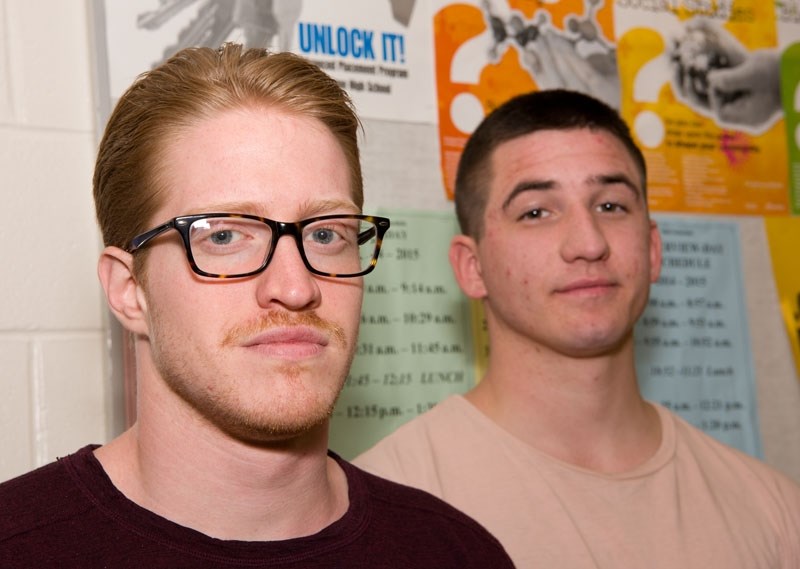Death was a wake-up call for recovering drug addicts Ryan Savoie and Brandon Shaw. Not the threat of it to themselves, the Edmonton residents told about 400 Paul Kane students Monday.
Death was a wake-up call for recovering drug addicts Ryan Savoie and Brandon Shaw.
Not the threat of it to themselves, the Edmonton residents told about 400 Paul Kane students Monday. Both had overdosed dozens of times on fentanyl, only to wake up in the hospital, enraged that they were still alive.
It was what it did to their friends.
For Savoie, 24, it was when his best friend died from his first overdose on fentanyl – a drug Savoie had introduced him to.
“I remember going to his funeral and not being able to show any emotion because I was so numb from all the drugs I was on,” he said.
For Shaw, 21, the turning point came when he had an argument with his girlfriend and left their apartment to get high. When he returned, he found her dead in the bathtub, her head underwater and a needle sticking out of her neck.
“That's how real this is,” he told the students.
“That's how quickly this can change.”
Savoie and Shaw are recovering fentanyl addicts enrolled with the Our House Addiction Recovery Centre in Edmonton. They were part of a panel discussion on fentanyl addiction that is making the rounds in St. Albert schools this week as part of National Addictions Awareness Week.
The drug of choice
Fentanyl is a highly addictive painkiller that's fast replacing heroin as the illicit drug of choice in Alberta, said RCMP Cpl. Brad McIntosh of the K Division's organized crime unit.
“You can order it on the Internet,” he said, and a coffee-bag's worth is worth $2.5 million on the street.
“Why did it all of a sudden spring up (in Alberta)? Well, it's because drug dealers like making money.”
The problem with fentanyl is that as little as two milligrams, or two salt grains, of it can cause a lethal overdose, McIntosh said. About 193 Albertans have died this year, as of September, from the drug.
There's no such thing as a typical fentanyl addict, McIntosh said; they come from all ages, races and genders, although men aged 30 to 45 make up most of the deaths from it. Some turn to it because they feel isolated and alone. Others start taking it medically, and get hooked because they're not properly weaned off it.
Savoie said he started doing marijuana in Grade 6 to deal with his family situation. That led to cocaine and ecstasy in high school, followed by fentanyl, morphine, heroin and OxyContin afterwards.
“As soon as I got into that (stuff), that became all what my life was about.”
Shaw said he was diagnosed with bipolar disorder when he was 12. He started off cutting himself, then got into alcohol before trying crack cocaine at a party when he was 15.
“I'm not going to tell you guys I hated it, because I absolutely loved it,” he said.
Shaw and Savoie turned to crime to support their habit, with Shaw moving to Vancouver to become a drug dealer.
“The crazy thing is when I couldn't afford heroin, I'd buy fentanyl, knowing it could potentially kill me,” Shaw said.
Savoie and Shaw said the withdrawal symptoms you get from opiates are so bad that you'll do anything to get another hit of the drugs.
“It's like the worst flu you've ever had times a thousand,” Savoie said.
Both said they lost a lot of friends to drug use, and that it drove both of them to contemplate, and in Savoie's case attempt, suicide. Both ended up in jail.
They agreed that it was only through friends and family sticking with them that they made it through rehab.
Shaw and Savoie encouraged people to be supportive of those they knew or suspected of being addicts, and advised parents to talk with their kids.
“If I would have had someone I felt comfortable with, I might have been able to do something different,” Savoie said.
And if you are struggling with addiction yourself, reach out to others for help, he said.
“Help is out there.”
Shaw and Savoie will be part of the free talk on fentanyl for parents at the Grandin Clubhouse this Nov. 17 at 7 p.m. Call 780-459-1720 for details.
